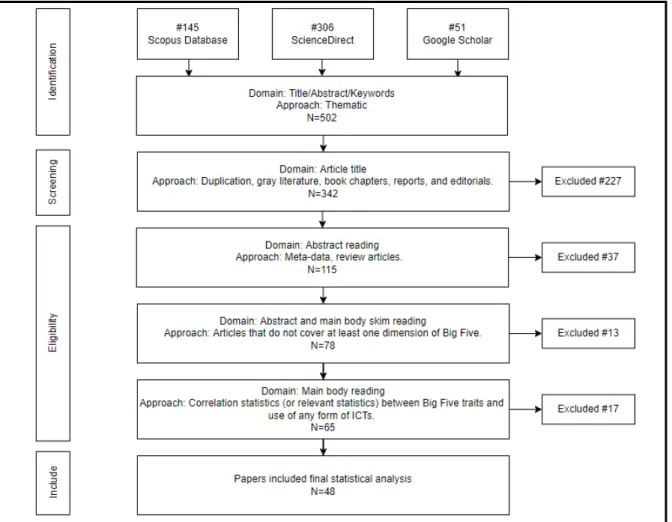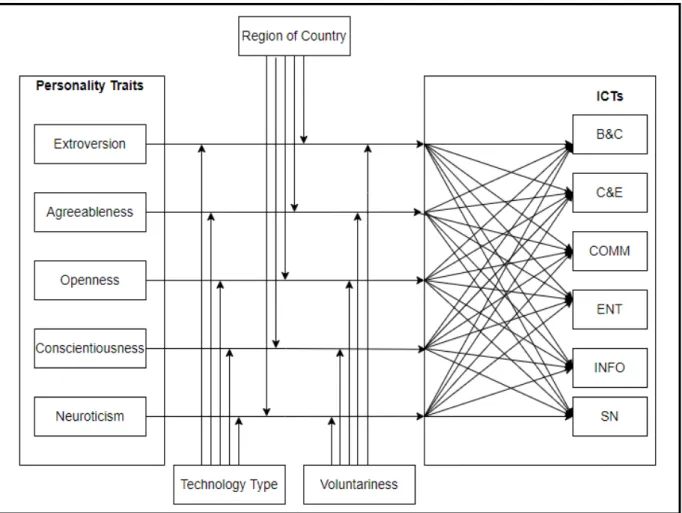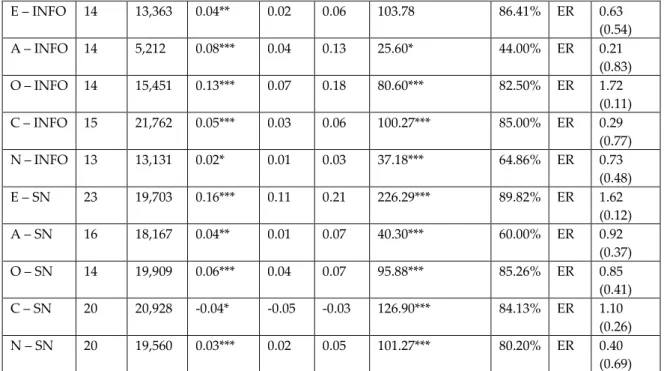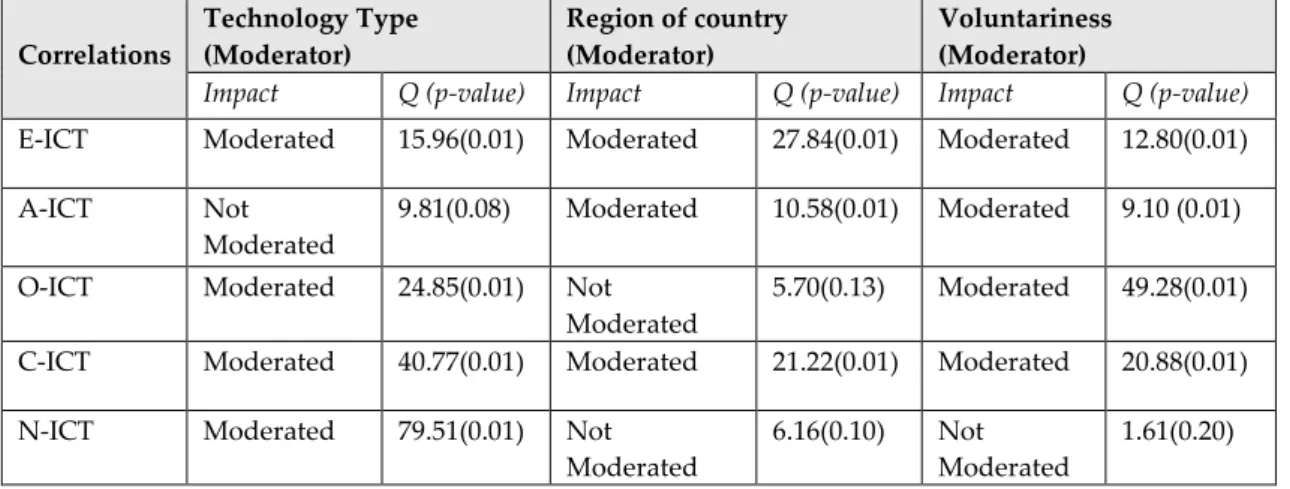People can be differentiated based on the scores on these five dimensions when using different ICTs (Chittaranjan et al., 2011; Kim et al., 2015). Similarly, the score on the 'agreeableness' scale was found to be associated with the use of news and business-related applications (Burtăverde et al., 2021), ERP applications (Benlian & Hess, 2010) and social networks. places (Lönnqvist et al., 2014). In contrast, low scorers tend to be emotionally resilient, well-adjusted, and relaxed (McCrae et al., 2008).
2020) argued that the type of technology exhibits a significant moderating effect on the relationship between individual characteristics and technology adoption (Wang et al., 2018; Zabkar et al., 2017). Meta-analysis is a statistical procedure that integrates the results of several independent studies that are considered to be combined (Egger et al., 1997). The motivations were centered on skill development, knowledge acquisition, self-development and generally feeling better about oneself (Chacón et al., 2017).
Motivations based on driving people to engage and interact with other people in informal settings (Chacón et al., 2017). Motivations oriented towards the acquisition and/or improvement of knowledge and experiences to improve the understanding of a certain phenomenon (Chacón et al., 2017).
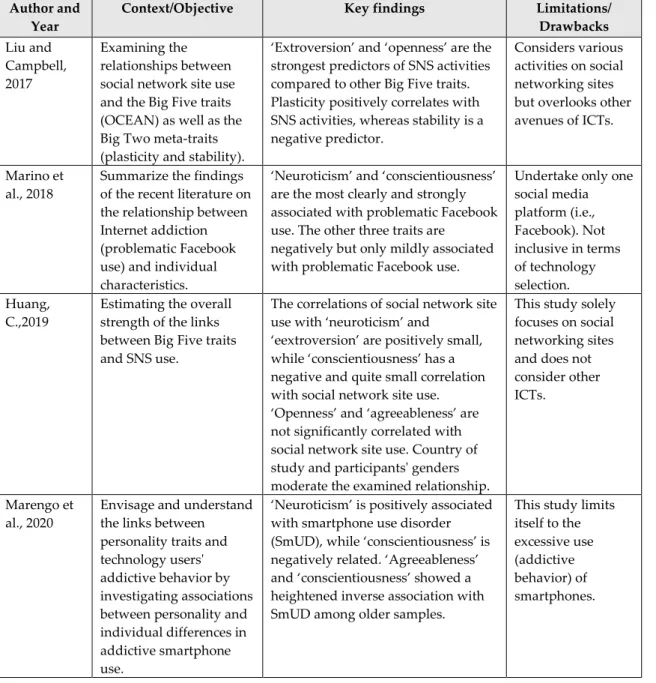
4 Results
Study Characteristics
The selected studies considered at least one of the Big Five personality traits as an independent variable (IV) and the use of any form of ICT as a dependent variable (DV).
Meta-analysis
Subgroup Analysis
Finally, we examined the impact of voluntariness on the personality-ICT use relationship by classifying the ICTs into two classes, that is, voluntary and non-voluntary. The results revealed that voluntariness (voluntary and non-voluntary) moderated all relationships (except for Neuroticism – ICT use) in a way that the Big Five – ICT use relationships become more significant in the case of non- voluntary ICT.
5 Discussion
Primary findings
Overall, the results of the meta-analysis show that all Big Five personality traits are significantly associated with ICT use in general, except 'agreeableness'. These findings are consistent with those of Rauschnabel et al. 2015) study, which stated that 'openness' plays a central role in the success of a newly introduced ICT. In particular, this personality trait showed significant positive correlations with 'career and education', 'information', along with 'business and commerce' based ICTs, while it showed significant negative correlations with 'social networking' based ICTs.
Next, 'career and education-based' ICTs, on the other hand, seemed to help include internet-based skills development courses, lectures, online courses, student assessment and online training. Therefore, in accordance with (Xu et al., 2016) and contrary to (Tsao, 2013), we observed a significant positive correlation between 'agreeableness' with. Consistent with Lin et al. 2017), our study reported that high scorers on 'agreeableness' are likely to use 'entertainment' and 'information' based ICT.
The variability in the use of ICT based on the type of technology has been consistently reported in existing literature (Bowden-Green et al., 2021; King & He, 2005; Lai et al., 2022). These results explain the variations in the correlation coefficient between personality traits and the use of ICTs. Similarly, the effect size of the correlation O – INFO was observed to be relatively larger and more significant.
Hence, 'mindfulness' showed a greater and positive effect for 'career and education', along with 'information' based ICTs. Therefore, “extroversion” exhibited a greater and positive correlation with social networking sites and “communication”-based ICTs. As a result, Asians are more interested in 'career and education' based ICT, due to their conscientious nature; while Europeans are more likely to use ICTs based on "information" and "social networks" due to their open personality (see Appendix 2).
In the same vein, the researchers also pointed to workload or work obligations as a crucial factor in the case of involuntary ICT use (Schlachter et al., 2018).
Implications
- Theoretical Implications
- Managerial Implications
Therefore, ICT selection and use decisions are determined by the congruence between personality traits and the utility of ICT. We noted that the relationships between personality traits and ICT use are uniformly stronger for non-voluntary ICTs, indicating that individuals with different personality types use work-related or non-voluntary ICTs in a similar pattern (please see Appendix 2). It can thus be inferred that organizational factors (such as job requirements) are more important in connection with non-voluntary ICT use.
Second, this study enriches the literature with knowledge on the role of individuals' personality traits in the use of different ICTs by statistically synthesizing the results of previous studies and establishing relationships between personality traits and six categories of ICTs. Third, this study focuses on and minimizes inconsistencies regarding the relationship between personality traits and the use of different forms of ICT, thereby providing a clearer picture of how personality traits are actually associated with the use of different forms of ICT ICT (or ICT in general). ). Previous studies reported the varying nature and strength of similar personality traits – ICT use relationships in terms of their statistical significance, i.e., positive significant, negative significant and non-significant.
In other words, the existing literature seemed to lack a comprehensive view of the importance of personality traits in ICT use. Next, we group similar ICTs into six distinct clusters, analyze previously reported relationships, and provide a comprehensive picture of how personality traits actually relate to different ICT use. The results can help the research community in developing a comprehensive understanding of the relationship between personality traits and the use of different types of ICTs and serve as a solid foundation for future studies.
Fourth, this study revealed three potential moderators: technology type, region of the country, and voluntariness, which influence the relationship between personality traits and ICT use. Finally, this study noted that some personality traits are more relevant when examining the adoption/use of specific ICTs that have different functionalities and provide certain benefits. Second, the nature and strength of the relationships between personality traits and ICT use suggest that technology providers need additional efforts to identify the cluster of target consumers with certain tendencies and preferences.
Information about the number and types of pre-installed applications and browsing history of users (with the permission of device users) can facilitate the identification of dominant personality traits.
Limitations and Future Research Directions
Third, variation in pairwise correlations implies that individual dispositions must be aligned with assigned tasks to optimize employee performance (Palmer et al., 2019; van der Schyff et al., 2020). For example, in the case of an information technology company, open employees could be assigned to test newly developed ICT and work using recently introduced ICT such as data analytics, machine learning, big data and cloud technology, while are low scores on "openness" could be assigned to work on common technologies, such as traditional database management using MS SQL, Microsoft Word and Microsoft Excel. We found differences between users in different cultures, which actually indicates the need to recognize culturally specific factors in determining the use of ICT and thereby ensuring the successful delivery and implementation of technology in local markets.
Voluntary use of ICT is subject to individual needs, wants and desires; therefore, ICT providers should focus more on psychological and functional incentives (as discussed in Table 4), user interface improvement, and personal marketing. Therefore, ICT providers are advised to change their business strategies regarding use cases. Although we examined the moderating effect of selected variables, data availability limitations in the selected articles and study design prevented us from assessing the roles of other moderators.
Future studies are recommended to provide more data on the age group, education level of the participants and additional relevant information, and to conduct their research in light of potential moderators. This could be addressed by conducting a meta-analysis of both correlation coefficients and path coefficients when sufficient data on such relationships are available in the literature (Zhang et al., 2022). Furthermore, an assessment of the use of technology in online/offline mode could have added value, but the use of technology in online/offline mode was not adequately reported in the shortlisted studies.
This finding may be attributed to the possibility of the presence of other variables that were not taken into account in our study. Therefore, in addition to individual personality, future studies are recommended to examine other individual and organizational variables related to the use of different ICTs. Finally, we noted that the studies included in the meta-analysis used a variety of instruments to measure the Big Five personality traits.
Although previous studies have examined the measurement tool for validity and reliability (Cohen & Baruth, 2017; Rauschnabel et al., 2015; . Tsao, 2013), we recommend that future studies use detailed taxonomy to capture an accurate picture of personality.
6 Conclusion
The number of studies containing path coefficients was less than the number of studies containing correlation statistics.
Use and satisfaction with problematic social media use among college students: A simultaneous examination of Big Five personality traits, social media platforms, and motives for social media use. The influence of personality traits (BFI-2-XS) on the use of Google or Facebook login for other online portals. Empirical results from two pre-market studies on the role of personality in individual awareness and intended adoption of Google Glass wearable devices.
The geographic distribution of the Big Five personality traits: Patterns and profiles of human self-description in 56 nations. Personality and technology acceptance: the influence of personality factors on the core constructs of the Technology Acceptance Model. To Tinder or not to Tinder, that is the question: An individual differences perspective on Tinder use and motivations.
The Impact of Personality on Acceptance of Privacy-Sensitive Technologies: A Comparative Study of RFID and Finger Vein Authentication Systems. Brothers in blood, yet strangers for purchasing global brands: A four-country study of the role of consumer personality.


